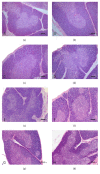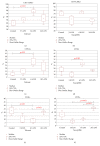Morphological Characteristics of the Thymus and Spleen and the Subpopulation Composition of Lymphocytes in Peripheral Blood during Systemic Inflammatory Response in Male Rats with Different Resistance to Hypoxia
- PMID: 31057785
- PMCID: PMC6463648
- DOI: 10.1155/2019/7584685
Morphological Characteristics of the Thymus and Spleen and the Subpopulation Composition of Lymphocytes in Peripheral Blood during Systemic Inflammatory Response in Male Rats with Different Resistance to Hypoxia
Abstract
On the model of the systemic inflammatory response (SIRS), induced by lipopolysaccharide (LPS), the morphological and functional changes in the thymus and spleen and the subpopulation composition of peripheral blood lymphocytes of rats differing in resistance to hypoxia were studied. It was demonstrated that the level of endotoxin in blood serum after 3 hours of LPS administration in susceptible-to-hypoxia rats was 64 times higher than in the control group, while in tolerant-to-hypoxia animals it was only 8 times higher in 6 hours. After 24 hours of LPS injection, only in susceptible-to-hypoxia rats did the level of C-reactive protein in blood serum increase. There is a difference in the dynamics of morphological changes of lymphoid organs after LPS injection in tolerant- and susceptible-to-hypoxia animals. After 3 hours of LPS administration, the tolerant-to-hypoxia rats showed no changes in the thymus, spleen, and subpopulation composition of lymphocytes in peripheral blood. After 6 hours there was only a decrease in B-lymphocytes and increase in cytotoxic T-lymphocytes and NK cells. After 1 day of LPS injection, the tolerant-to-hypoxia rats had devastation in PALS of the spleen. After 3 hours of LPS injection the susceptible-to-hypoxia animals had reactive changes in the lymphoid organs: decrease of the thymus cortex, narrowing of the marginal zones of spleen lymphoid follicles, widening of their germinal centers, and a decrease in the absolute number of cytotoxic T-lymphocytes, NK cells, and B-lymphocytes. After 24 hours of LPS injection the tolerant-to-hypoxia animals had a greater absolute number of T-lymphocytes and NK cells in comparison with the susceptible rats. Thus, in animals with different resistance to hypoxia the LPS-induced SIRS is characterized by different dynamics of morphological and functional changes of the thymus and spleen. The obtained data will serve as a basis for the development of new individual approaches to the prevention and treatment of infectious and inflammatory diseases.
Figures








Similar articles
-
Morphofunctional changes in the immune system in colitis-associated colorectal cancer in tolerant and susceptible to hypoxia mice.PeerJ. 2025 Feb 25;13:e19024. doi: 10.7717/peerj.19024. eCollection 2025. PeerJ. 2025. PMID: 40028198 Free PMC article.
-
Dependence of the severity of the systemic inflammatory response on resistance to hypoxia in male Wistar rats.J Inflamm Res. 2019 Mar 11;12:73-86. doi: 10.2147/JIR.S194581. eCollection 2019. J Inflamm Res. 2019. PMID: 30881082 Free PMC article.
-
Sex differences of inflammation in target organs, induced by intraperitoneal injection of lipopolysaccharide, depend on its dose.J Inflamm Res. 2018 Nov 8;11:431-445. doi: 10.2147/JIR.S178288. eCollection 2018. J Inflamm Res. 2018. PMID: 30519071 Free PMC article.
-
The induction of hapten-specific immunological tolerance and immunity in B lymphocytes. VI. Differential tolerance susceptibility in adult spleen as a function of B-cell maturation level.J Exp Med. 1979 Sep 19;150(3):491-506. doi: 10.1084/jem.150.3.491. J Exp Med. 1979. PMID: 158060 Free PMC article. Review.
-
Some endocrine aspects of the thymus gland.Jpn J Med Sci Biol. 1976 Dec;29(6):289-321. doi: 10.7883/yoken1952.29.289. Jpn J Med Sci Biol. 1976. PMID: 67231 Review.
Cited by
-
Differences in Tolerance to Hypoxia: Physiological, Biochemical, and Molecular-Biological Characteristics.Biomedicines. 2020 Oct 18;8(10):428. doi: 10.3390/biomedicines8100428. Biomedicines. 2020. PMID: 33080959 Free PMC article. Review.
-
Cell-free immunomodulatory biomaterials mediated in situ periodontal multi-tissue regeneration and their immunopathophysiological processes.Mater Today Bio. 2022 Sep 26;16:100432. doi: 10.1016/j.mtbio.2022.100432. eCollection 2022 Dec. Mater Today Bio. 2022. PMID: 36204216 Free PMC article.
-
Morphofunctional changes in the immune system in colitis-associated colorectal cancer in tolerant and susceptible to hypoxia mice.PeerJ. 2025 Feb 25;13:e19024. doi: 10.7717/peerj.19024. eCollection 2025. PeerJ. 2025. PMID: 40028198 Free PMC article.
-
Age-related differences in hypoxia-associated genes and cytokine profile in male Wistar rats.Heliyon. 2021 Sep 28;7(9):e08085. doi: 10.1016/j.heliyon.2021.e08085. eCollection 2021 Sep. Heliyon. 2021. PMID: 34632150 Free PMC article.
-
Molecular and phenotypic distinctions of macrophages in tolerant and susceptible to hypoxia rats.PeerJ. 2023 Oct 10;11:e16052. doi: 10.7717/peerj.16052. eCollection 2023. PeerJ. 2023. PMID: 37842051 Free PMC article.
References
-
- Ghosh D., Kumar R., Pal K. Individual variation in response to simulated hypoxic stress of rats. Indian Journal of Experimental Biology. 2012;50:744–748. - PubMed
LinkOut - more resources
Full Text Sources
Research Materials

